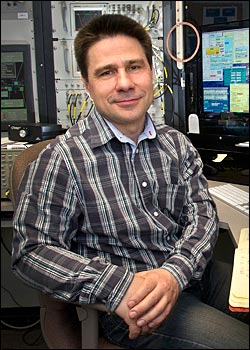Brookhaven Lab Physicist Vitaly Yakimenko Receives IEEE Particle Accelerator Science and Technology Award
April 19, 2012

Physicist Vitaly Yakimenko in the control room of Brookhaven’s Accelerator Test Facility.
UPTON, NY - The Institute of Electrical and Electronics Engineers/Nuclear and Plasma Science Society has honored Brookhaven physicist Vitaly Yakimenko with the 2012 Particle Accelerator Science and Technology Award. IEEE, the world’s largest professional association dedicated to technology innovation, recognized Yakimenko for outstanding “contributions to high-brightness electron beams and their application to advanced accelerators and light sources.” He will receive the award at the 2012 International Particle Accelerator Conference on May 24 at the Morial Convention Center in New Orleans.
“I was surprised and excited to hear about this honor,” said Yakimenko, who became the director of Brookhaven’s Accelerator Test Facility (ATF) in 2005. “It’s wonderful to know that people are paying attention to the work we do at Brookhaven. I am thankful to my collaborators at the ATF and the large community of visiting scientists who helped drive these innovations in fundamental research.”
Yakimenko dedicates much of his research at Brookhaven Lab to developing very bright beam sources and advanced particle accelerators. IEEE/NPSS honored his work measuring electron beam “phase space” — a mathematical description of all possible beam positions and momentums — which helped identify problems and correct them with new beam-stabilization methods. When accelerated at facilities such as Brookhaven’s National Synchrotron Light Source (NSLS), electron beams generate high-energy photons used to probe materials at the atomic level. Yakimenko’s research helped improve NSLS technology and push fundamental research in everything from alternative energy sources to biology.
Before he joined Brookhaven Lab, Yakimenko performed research calculating particle spin dynamics, which led to accurate beam polarizations — orienting particles in a beam so that their spins are aligned in a particular direction — in major high-energy particle accelerators, including Brookhaven’s Relativistic Heavy Ion Collider (RHIC), Germany’s Hadron-Electron Ring Accelerator (HERA), and CERN’s Large Electron Positron collider (LEP). Yakimenko has also developed breakthrough techniques in laser manipulation, such as sub-micron beam emittance from radio-frequency photoinjectors and the observation of mono energetic ion beams produced with a CO2 laser pulse.
“Brookhaven is very diverse – there’s no time to get stuck on something when you’re surrounded by this constant flow of new ideas and results,” Yakimenko said. “I am always stimulated by the accomplishments of my colleagues and the opportunity to tackle multiple challenges at the same time.”
Yakimenko currently juggles around 15 ongoing projects, which he called the usual workload, ranging from experimental design to organizing the meetings for Brookhaven accelerator facility users.
Yakimenko earned his Ph.D. in physics from the Institute for Nuclear Physics in Novosibirsk, Russia. Before joining Brookhaven in 1996 as a research associate, he worked at the GSI heavy ion research center in Darmstadt, Germany and at the German Electron Synchrotron (DESY) in Hamburg.
2012-2979 | INT/EXT | Newsroom









